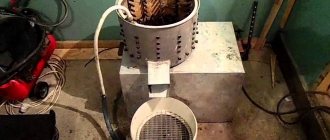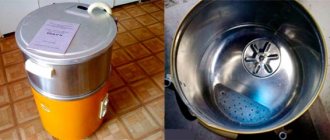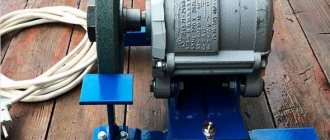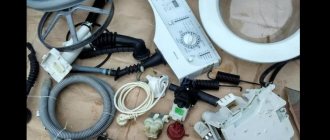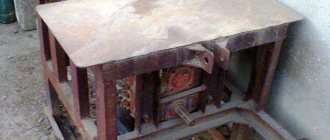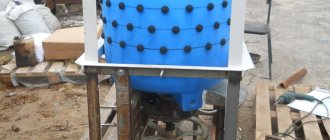Good motors are in washing machines, even when the latter breaks down and is thrown away - the motors are left and later used in the household (for example, for a mini-machine). Here we will consider a typical motor from an automatic washing machine (new and old type) and a diagram of its separate connection to 220 V. But first, let me lay out a little boring theory, which you can skip by moving on to the second, practical, part of the article.
Theory of operation of a 220 V electric motor
Asynchronous motors for single-phase networks are mainly motors with two-phase windings and an auxiliary phase taken from a capacitor. Such motors are used in household appliances. A similar motor is used, in particular, to drive a washing machine. In addition to two-phase winding motors, three-phase winding motors are sometimes used in some other household appliances.
During direct starting, the motor can receive a current from the network that significantly exceeds its rated value. This current is called the motor starting current, and its value varies in the region Ir = 5-7In .
One way to reduce the inrush current is to use a star-delta switch. A motor designed to operate the stator in a triangular connection at a given mains voltage is connected to the star system at the time of start-up:
Due to the reduced voltage supplied to the stator winding phase and the change in connections from delta to star, the current taken from the network will be reduced by three times compared to the starting current in a delta circuit. However, when connected to a star, the motor has three times less starting torque, which makes it impossible to use this method during heavy starting (with a heavy load).
Advantages of asynchronous motors for washing machines
The electric motor that rotates the drum is the heart of the washing machine. The drive in the very first versions of the machines was belts that rotated the container with laundry.
But today the asynchronous unit, which converts electricity into mechanical energy, has been significantly improved.
Most often, washing machine circuits contain asynchronous electric motors, consisting of a stator, which does not move and serves as both a magnetic circuit and a supporting structure, and a moving rotor that rotates the drum. An asynchronous motor operates due to the interaction of the magnetic alternating fields of these nodes.
We recommend:
- Connection diagram for solar panels of a country house
- Unusual skateboards that move themselves
- Assemble a solar battery with your own hands
Asynchronous motors are divided into two-phase, rare, and three-phase.
The advantages of asynchronous units include:
- simple design;
- simple maintenance, including replacement of worn bearings and
- periodic lubrication of the electric motor;
- silent operation;
- relative cheapness.
- Of course, there are also disadvantages:
- low efficiency;
- big sizes;
- low power.
Such motors are usually installed on inexpensive models.
Capacitor for electric motor
For small motors (<1 kW), the value of the starting capacitor can be determined from the relationship:
C [uF] = (1800 x Pn) / U2
where Pn [W] – rated motor power, U [V] – supply voltage.
This formula is also suitable for calculating the starting capacitor value for single-phase start-phase motors.
For larger motors (>1kW) a capacitance of around 70uF/1kW is suggested. It is necessary to use starting capacitors with operating voltages of 400..630 V AC.
You can omit the calculations and simply connect a standard motor from the washing machine to 1 phase 220 V through a 7 microfarad capacitor connected between the required terminals. Connect the first power wire to the middle, and the second, depending on the direction of rotation, to one of the capacitor wires. The power drop will be 30% - this is in theory.
The issue of choosing a capacitor is easily resolved. Here are examples of capacitance values for different engine powers.
Pn [W] 90 120 180 250 370 550 750 1100 S [µF] 4 5 6 8 12 16 20 30
Useful: Connecting an external microphone to a laptop
The rotation power in the washing machine is the same in both directions. These are motors with a typical connection for a single-phase motor. The main winding is connected directly to 220 V and a phase winding is connected in parallel with it along with a series-connected capacitor. If you reverse the phase winding wires, the motor will rotate in the other direction, but the power will be slightly less. This circuit works during the spin cycle. The same for slow and fast rotations - the capacitance switches inside the washer from 7 µF to 16 µF. Read more about the capacitor here
Call the master
If you are unable to repair and replace the Indesit washing machine motor on your own, you need to seek help from a specialist. There are several ways to find a master:
According to the advertisement . Repairers place information about their services in newspapers, post them on poles, and deliver business cards to mailboxes.- Contact the service center . The main thing is that this organization establishes itself well in the locality.
- By word of mouth . It is possible that relatives or friends have used a similar service in the recent past. If they recommend a professional, you can trust them.
- Internet message boards . There are a lot of them on the Internet, so you can find a master in every city.
Most craftsmen do not charge money for a visit if the person agrees to pay for the repairs. This information needs to be clarified at the stage of calling a specialist. Before choosing a repairman, you need to study reviews of his work. Moreover, it is better to do this on a site other than the one on which he placed an advertisement about his services.
Approximate prices:
- replacement of brushes – from 1400 rubles;
- engine replacement or repair – from 2000 rubles.
As a rule, the brushes are guaranteed for 6 months, and the motor is 1 year. Prices do not include the cost of parts (if they need to be replaced).
Before agreeing to repair the engine, you need to clarify its final cost with a specialist. An honest master will immediately name the price. If there is a need for repairs, he can announce the estimated cost, but there will be no significant deviations from it.
A lot of important and useful information about repairing Indesit washing machines is presented in this section.
Connecting the motor from the SMA
This motor contains two independent windings:
for synchronous speed 3000 rpm - two-phase winding.
for synchronous speed 500 rpm - symmetrical three-phase winding . The three-phase connection system allows you to change the rotation speed by switching the power supply to the winding.
An older type motor usually has 5 wires, black, blue, white, red and green. A series of measurements were carried out to determine the windings and the resistance between them:
- Blue-black 85 Ohm
- Blue-green 85 Ohm
- Black-green 80 Ohm
- White-blue 15 Ohm
- White-red 30 Ohm
Connecting an old electric motor requires finding the starting winding using a multimeter.
- ON - initial winding . It is designed to start the engine only and starts at the very beginning until the engine begins to rotate.
- OB – field winding . This is the work winding that runs constantly and constantly turns the motor.
- SB – button from which voltage is supplied to the starting coil and turned off when the engine starts.
Motor connection diagram in an old washing machine
Everything is more serious here. You need to find 2 pairs of pins that match each other using a multimeter (toaster). To do this, fix the device on any of the terminals and find the paired one using a probe. The two remaining pins will be the second pair automatically.
Now determine the location of the working and starting windings by measuring the resistance. The starting point (PO), which creates the starting torque, is found by its higher resistance. The disturbance winding (OB) creates a magnetic field.
Connecting the electric motor from a new washing machine
If you look at the terminal block with the wires on the front, usually the first two wires on the left are the tach wires, which measure and regulate the rotation speed of the washing machine motor. We don’t need them - they are crossed out with a cross.
In different models of washing machines, the wires differ in color, but the connection principle remains the same. You just need to find the necessary wires by testing them with a multimeter.
A working tachogenerator in a quiet state usually has a resistance of 50-100 Ohms. You will immediately find these wires and disconnect them.
If you need to change the engine speed in the opposite direction, simply drag the jumper to the other pins. Look at the diagrams to see what it looks like.
Two contacts go through the brushes to the rotor windings, and the other two contacts go to the stator winding. The remaining contacts are a sensor for measuring the motor rotation speed. The rotor and stator windings are connected in series and by changing the ends of one of the windings, you change the direction of rotation. Without an electronic regulator, the engine will accelerate to several thousand revolutions per minute (as at maximum spin).
- Read how to regulate the motor rotation speed from the SMA here.
How to use the engine
The electric motors that modern units, such as those from Indesit, are equipped with are quite reliable and durable. And even a part from an old washing machine of a brand like Vyatka can last long after the equipment itself has become hopelessly outdated.
Based on the engine from a washing machine, you can make a grinding machine
In a washing machine, an electric motor rotates the shaft, which drives the drum. If the part is removed from the unit, a wide variety of attachments can be attached to the shaft, resulting in new tools and accessories. The most common ways to use an electric motor are:
- Sharpening apparatus (sharpening machine). It is considered the simplest option for using a motor. The engine is mounted on a flat surface, and a round sharpening stone is attached to the shaft. The machine can be used for sharpening knives, scissors or tools.
- Concrete mixer. To make it, we use a motor and a tank from an old washing machine.
- Special vibrator or vibrating table for the production of concrete products. The vibrations created by the motor can contribute to the shrinkage of concrete, and it is this property that is used in the manufacture of these tools.
- Device for grinding pet food. To do this, it is enough to secure the knives on the shaft. This device can also be used to chop large volumes of feed, such as grass for cattle.
We have listed only a small part of the devices that can be obtained from a washing machine motor. In order to make one of them, or come up with your own application, you need to know how to connect the motor so that the winding does not burn out.
Diagram of a simple motor speed controller
Of course, the speed is best controlled by an inverter, but for simple amateur devices, simple homemade regulators should be sufficient.
Useful: Digital push-button potentiometer - volume control
The minimum speed obtained with this circuit was 200 rpm. C2 is a smooth start. Soft start works great at idle, although with a load on the shaft, if necessary, select R5 = 0 - 3 kOhm depending on the load; R6 = 18 – 51 Ohm depending on the triac; R4 = 3 – 10 kOhm – this is protection T3; RR1 = 2 -10 kOhm – the speed controller is galvanically connected to the network, protection from mains voltage is required. There are potentiometers with a plastic axis; it is advisable to use them.
Connection via voltage regulator
The easiest way to regulate the electric motor from a washing machine is to connect any available device to change the voltage (dimmer, automatic drill, etc.). As a rule, such regulators have a switch in the form of a rotating toggle switch, changing the position of which leads to a decrease or increase in the speed of the electric motor.
The standard diagram for connecting the electric motor of a washing machine using a ready-made voltage regulator is as follows:
- one anchor and one coil outputs are connected;
- the second coil output is allocated for connection to the electrical network;
- the second anchor output is connected to one regulator output;
- the second output of the regulator is connected to the mains.
After connecting the regulator, start the electric motor for the washing machine and check its operation at minimum power. Without a load, it is difficult to visually determine how much power is set on the dimmer, since the revolutions still remain impressive. But if, for example, you lean a wooden block against the axis, the electric motor from the washing machine will begin to slow down and may even stop completely. It follows from this that when the voltage decreases, the electric motor for the washing machine catastrophically loses power, which is often unacceptable even for homemade products. Therefore, this method, although simple, is ineffective.
Possible breakdowns
Now you know how to connect an electric motor to give it a whole new life, but a small incident may occur: the motor will not start.
It is necessary to understand the reasons and find a way to solve the problem. Check engine heating after running for 1 minute. In such a short period, the heat does not have time to transfer to all components and the place of active heating can be clearly fixed: the stator, bearing assembly, or something else.
The main factors for rapid heating are:
Then we examine every 5 minutes of work; it is enough to do this 3 times. If the reason is the bearing, then it needs to be disassembled, lubricated or replaced. During further operation, we regularly monitor the heating of the motor. Avoid excessive overheating, as repairs can cause huge damage to your home budget.
Source
Tips for working
When using a powerful machine motor in a new guise, you must remember 2 important nuances of connecting it:
Before connecting, we recommend that you understand the wires of different colors located there on the transfer case:
Be prepared for the fact that in different modifications the wires differ in color, but the principle of their connection remains constant. To identify pairs, ring the wires in order: those going to the tachogenerator have a resistance of 60-70 Ohms. Move them aside and secure them together with electrical tape so that they do not interfere. Ring the other wires to find a pair for them.
Types of electric motors
An electric motor is a machine operating on electricity that moves various elements using a drive. They produce asynchronous and synchronous units .
Synchronous motor
It has been established since school days that when magnets approach each other, they attract or repel.
The first case appears at opposite magnetic poles, the second - at like ones. We are talking about stable magnets and the magnetic field they constantly organize. In addition to those presented, there are unstable magnets. Everyone, without exception, remembers the example from the textbook: the picture shows a magnet in the shape of an ordinary horseshoe. Between its poles there is a frame made in the shape of a horseshoe with half rings. Current was supplied to the frame.
Since the magnet rejects the same poles and attracts different ones, an electromagnetic field appears around this frame, which turns it in a vertical position. As a result, it is acted upon by a current opposite to the main case in terms of the symbol. The modified polarity rotates the frame and again sends it to the horizontal area. The operation of a synchronous electric motor is based on this belief.
In this circuit, current is supplied to the rotor winding , represented by a frame. The source that creates the electromagnetic field is the windings. The stator performs the functions of a magnet. In addition, it is made of windings or a set of stable magnets.
The rotor speed of such an electric motor is the same as the current supplied to the winding terminals, i.e. they work simultaneously, which gives the electric motor its name.
Asynchronous device
To understand the principle of operation, let’s remember the picture: a frame (but without half rings) is located between the magnetic poles.
The magnet is made in the shape of a horseshoe, the ends of which are united. We begin to slowly rotate it around the frame, observing what is happening. Until a certain point, the frame does not move. Further, at a specific angle of rotation of the magnet, it begins to spin behind it at a speed less than the speed of the latter. They do not work simultaneously, which is why the motors are called asynchronous.
In a real electric motor, a magnet is an electrical winding placed in the slots of the stator into which electric current is supplied. The rotor is considered a frame. In its grooves there are short-connected plates . That's what they call it - short-circuited .
Differences between electric motors
Externally, the motors are difficult to recognize. Their main difference is the operating rule. They also differ in their scope of application: synchronous, more complex in design, are used to drive equipment such as pumps, compressors, etc., i.e., operating at constant speed.
In asynchronous ones, as the overload increases, the rotation frequency decreases. They are supplied with a huge number of devices.



